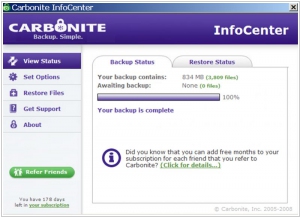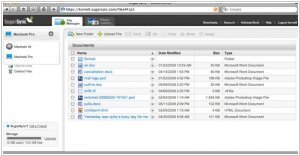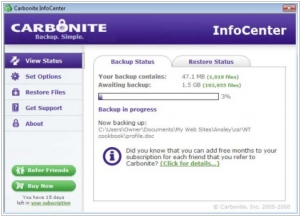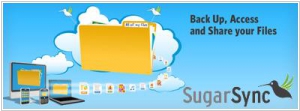Carbonite vs SugarSync
August 26, 2023 | Author: Michael Stromann
17

Carbonite is an online backup service, available to Windows and Mac users, that backs up documents, e-mails, music, photos, and settings. Carbonite keeps small businesses and home offices running smoothly. We offer a comprehensive suite of affordable services for data protection, recovery and anytime, anywhere accessibility. From running your small business to running your household, our goal is to provide secure and affordable cloud backup for all your files.
4

SugarSync makes it easy to backup, share and access your files, anytime, anywhere. With SugarSync you get online cloud storage for all your files — documents, music, photos, and video. When you make a change or add files on any of your PC or Mac computers, SugarSync automatically syncs your files to the cloud, where you can access them from any Internet-connected device — including your smartphone or iPad.
Carbonite and SugarSync are both cloud backup and synchronization solutions, but they have key differences in their features and approach. Carbonite focuses primarily on backup, offering automatic and continuous backup of files and folders on a computer. It provides features like file versioning, remote access, and mobile apps, making it suitable for users who prioritize data backup and recovery. SugarSync, on the other hand, is a cloud storage and synchronization platform that emphasizes file syncing and sharing across multiple devices. It offers features like folder syncing, file sharing with others, collaboration tools, and integration with popular productivity apps. SugarSync is known for its flexibility and cross-platform compatibility.
See also: Top 10 Cloud Storages
See also: Top 10 Cloud Storages
Carbonite vs SugarSync in our news:
2019. OpenText buys online backup firm Carbonite for $1.42B

Carbonite, a company specializing in data backup, has recently entered into a purchase agreement with OpenText, a prominent enterprise information management firm, for a substantial amount of $1.42 billion. In recent years, Carbonite has transitioned from its traditional data backup focus to becoming a proactive and defensive security company. To strengthen its security offerings and defend against emerging threats such as ransomware, Carbonite made strategic acquisitions. In February, the company acquired endpoint security firm Webroot for $618.5 million in an all-cash transaction. Just a year prior, Carbonite purchased cloud backup service Mozy for $145 million. These acquisitions have contributed to Carbonite's evolution and expansion into the security domain.
2009. SugarSync opens business accounts

Recently we wrote about to leading file collaboration services - DropBox and Box.net. Now it's time to add to this short list one more tool - SugarSync. During the last few months this service added some very important features: good version control system, free 2Gb subscription plan, iPhone and Android apps and the suitable file sending feature. And yesterday they unveiled business accounts that enable to administrate up to 100 user accounts - the feature that is much expected from DropBox. Besides the ability to create/delete user accounts, administrator can set storage limits for each user (and receive alerts when user is near limit) and easily scale the whole company storage volume. And of course, all payments are centralized. ***
2009. SugarSync comes to Android
SugarSync, the service for managing file syncing, has introduced a new version specifically designed for Android phones and Netbooks. With SugarSync for Android, users can conveniently view and download files on their Android devices, as well as upload local files to their free or premium SugarSync repository. This functionality allows for remote access and online backup, enabling users to access files from various desktops, laptops, or mobile phones across different platforms or via the web. Additionally, the feature enables users to easily share files and folders directly from their Android phones.
2009. SugarSync offers free accounts
SugarSync, a service for synchronizing and backing up files, has introduced free accounts, expanding its offerings beyond the previous minimum cost of $4.99 per month or $49.99 per year. However, there is a limitation on storage space, with free accounts only allowing 2GB of storage. While this may not be sufficient for large file or music backups, it can still prove valuable for syncing a few substantial files across multiple devices, such as accessing project files while on the go. SugarSync stands out from competitors like Dropbox by providing extensive support for mobile devices, including clients for iPhone/iPod Touch, BlackBerry, and Windows Mobile. The newly announced free accounts also include access to these mobile clients, further enhancing their appeal.
2008. Get remote file access, management on your iPhone with Sugarsync
Sugarsync, a premium but highly effective file-syncing and backup solution, has introduced an impressive new iPhone application. This app grants users access to all the files stored on their Sugarsync-linked computers. The standout feature is the lightning-fast updates delivered through push technology, instantly notifying users when a file has been modified by them or another user. During a demo, I witnessed the app in action and was impressed by its sleek design. Each linked computer is represented by a unique icon, and accessing files is as simple as selecting one from a visually appealing spinning wheel interface. One of the app's strengths is its ability to sync multiple computers and seamlessly transfer data between them in the background. In the mobile realm, this system proves particularly useful when sharing large files that cannot be easily emailed directly from the phone. Sugarsync's solution is to provide recipients with a download link, enabling them to retrieve the file through their browser's download manager. The app also offers remote file management options, allowing users to move, rename, and delete files from a distance. Thanks to the live sync server, any changes made are immediately propagated. In the demo, changes made from the desktop to the phone and vice versa were pushed out in approximately one second, even on EDGE networks. Currently, the app faces some limitations regarding file compatibility. While it handles most iPhone-compatible file types (such as MS Office documents, PDFs, and QuickTime movie files) with ease, it has encountered issues with specific movie codecs and audio files. However, supported audio files should play without problems; the challenge lies in enabling multitasking while music is playing, as it currently redirects the file to the full-screen QuickTime player. Future versions are expected to address this limitation. The Sugarsync iPhone application itself is free, but the Sugarsync service is a paid offering. Users can take advantage of a 45-day free trial for the 10GB service, which typically costs around three dollars per month.
2008. SugarSync Adds File Send Feature
The field of file synchronization and backup is seeing significant growth, with Syncplicity, SugarSync, Mozy, and Microsoft's Live Mesh competing to offer cross-platform, cross-device, and cloud-accessible data services. SugarSync, one of the players in this space, has recently announced a development that blurs the lines between synchronization and collaboration even further. With SugarSync's new functionality, users can now send any file from their desktop, web, or mobile SugarSync application, regardless of size or number of recipients. The recipients receive a secure link via email, granting them access to the file for 21 days. If these recipients also use SugarSync, they have the option to synchronize the file across all their devices. The sender receives a notification once the recipients begin downloading the file. To enhance security, the email link is time-limited to 1 day. This development is significant because it expands the scope of synchronization services beyond multiple device access and backup. While Live Mesh offered collaboration, it was limited to Windows. SugarSync's solution, on the other hand, is cross-platform, marking a game-changing move. Having used SugarSync for six months myself to back up and sync files across multiple machines and the web, I can attest to its seamless and reliable performance. It works quietly in the background, ensuring everything stays up to date. Today's updates give SugarSync a unique advantage over other synchronization providers and propel it further into the realm of collaboration solutions.
2008. SugarSync: Most useful sync tool ever. But you'll pay for it
Today marks the public beta launch of SugarSync, a file synchronization product developed by Sharpcast. Unlike other sync tools such as FolderShare and BeInSync, SugarSync utilizes a web-based clearinghouse for file synchronization, ensuring that data on multiple devices remains consistent. The system uploads all files to a server, allowing connected devices to access and update the latest file versions when they come online. SugarSync also offers a mobile component, enabling users to view synced files on their smartphones and automatically upload new photos to their PCs. Despite its efficient performance, the service comes at a cost due to the storage and bandwidth requirements of the SugarSync servers. With pricing starting at $49 per year for 10GB of storage, it may not be the most cost-effective solution for all users. However, the product offers advantages such as online backup functionality and the ability to transcode files for display on various devices. SugarSync simplifies setup and configuration and provides convenient access to data from any connected device or computer. While the service ensures encryption and security, it is important to note that SugarSync holds the encryption keys, although there may be an option for users to set their own keys in the future. Despite its potential, the current pricing structure may limit the widespread adoption of SugarSync until more affordable options become available.


